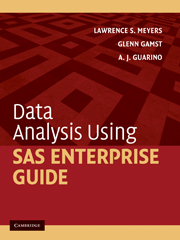Book contents
- Frontmatter
- Contents
- Preface
- Acknowledgments
- I Introducing SAS Enterprise Guide
- II Performing Analyses and Viewing Output
- III Manipulating Data
- IV Describing Data
- V Score Distribution Assumptions
- VI Correlation and Prediction
- 15 Bivariate Correlation: Pearson Product–Moment and Spearman Rho Correlations
- 16 Simple Linear Regression
- 17 Multiple Linear Regression
- 18 Simple Logistic Regression
- 19 Multiple Logistic Regression
- VII Comparing Means: The t Test
- VIII Comparing Means: ANOVA
- IX Nonparametric Procedures
- X Advanced ANOVA Techniques
- XI Analysis of Structure
- References
- Author Index
- Subject Index
15 - Bivariate Correlation: Pearson Product–Moment and Spearman Rho Correlations
Published online by Cambridge University Press: 05 June 2012
- Frontmatter
- Contents
- Preface
- Acknowledgments
- I Introducing SAS Enterprise Guide
- II Performing Analyses and Viewing Output
- III Manipulating Data
- IV Describing Data
- V Score Distribution Assumptions
- VI Correlation and Prediction
- 15 Bivariate Correlation: Pearson Product–Moment and Spearman Rho Correlations
- 16 Simple Linear Regression
- 17 Multiple Linear Regression
- 18 Simple Logistic Regression
- 19 Multiple Logistic Regression
- VII Comparing Means: The t Test
- VIII Comparing Means: ANOVA
- IX Nonparametric Procedures
- X Advanced ANOVA Techniques
- XI Analysis of Structure
- References
- Author Index
- Subject Index
Summary
Overview
Correlation in statistical terms is a way to assess the degree of relationship or association that is observed between variables. Bivariate correlation focuses on the relationship between two (bi-) variables (-variate). Behavioral and social research almost always is concerned about the relationship of two or more variables, and so correlation plays a central role in such ventures.
Some history
Sir Francis Galton, the late 19th-century geographer, meteorologist, and statistician, was perhaps best known for his study of the inheritance of both physical and intellectual characteristics. As early as 1875, he distributed packets of sweet pea seeds to seven of his friends. Each packet contained seeds of uniform weight, but the weight of the seeds varied across packets. These friends were asked to plant the seeds, raise several generations of the plants, and then send the last generation of seeds back to Galton (Stanton, 2001). Upon graphing the results of this experiment he discovered that relatively heavier- and relatively lighter-weighted parent seeds ultimately produced seeds of less extreme weight. Later, Galton, on the basis of some physical characteristics of people and their family history, determined that both taller than average and shorter than average men have family and offspring who deviate less from the mean than they do. Galton presented this latter work in 1886 as the framework for introducing the concept of regression “towards the level of mediocrity” (Galton, 1886, p. 492) – what we now call regression toward the mean.
- Type
- Chapter
- Information
- Data Analysis Using SAS Enterprise Guide , pp. 155 - 161Publisher: Cambridge University PressPrint publication year: 2009



